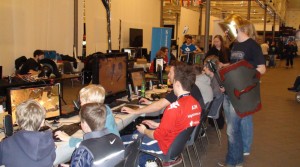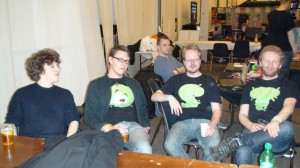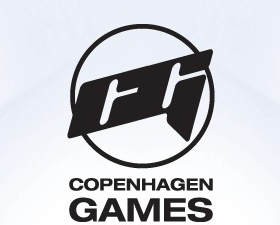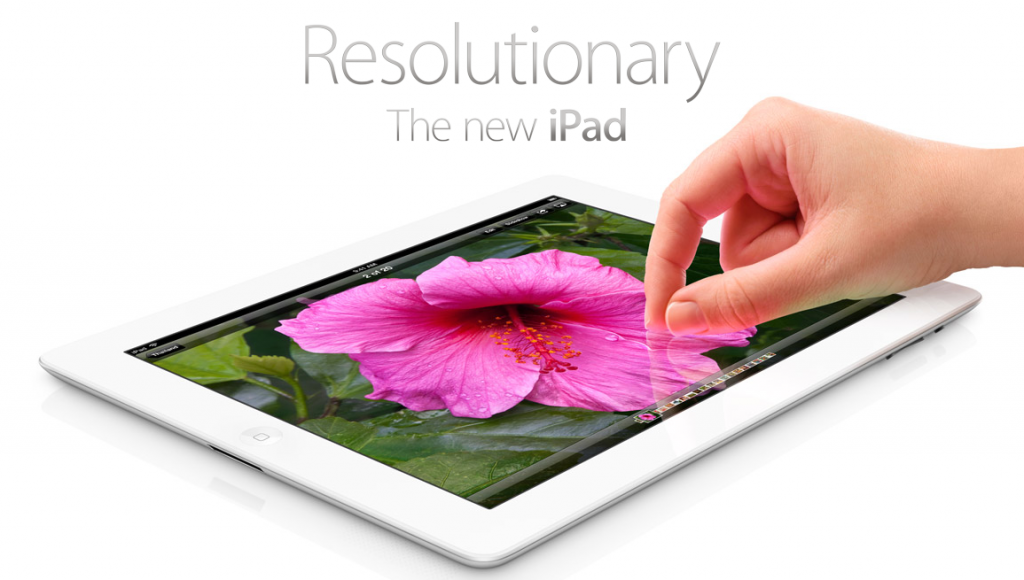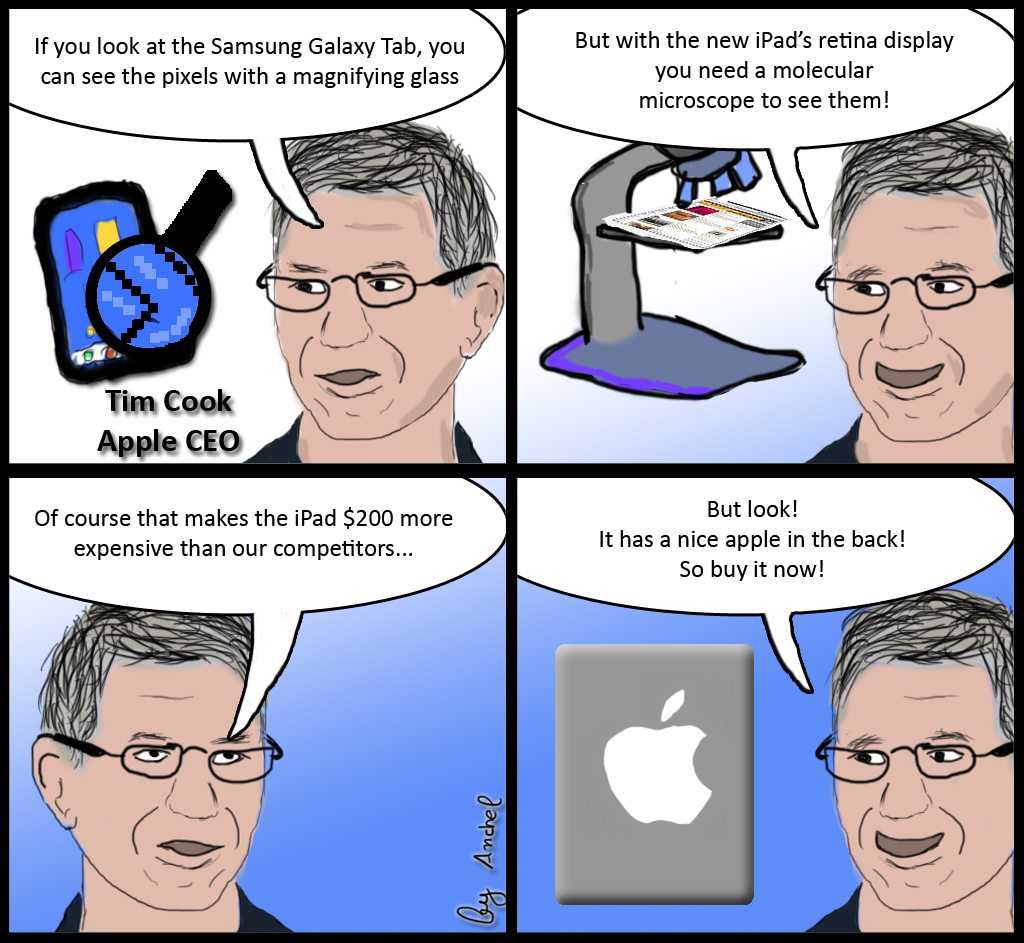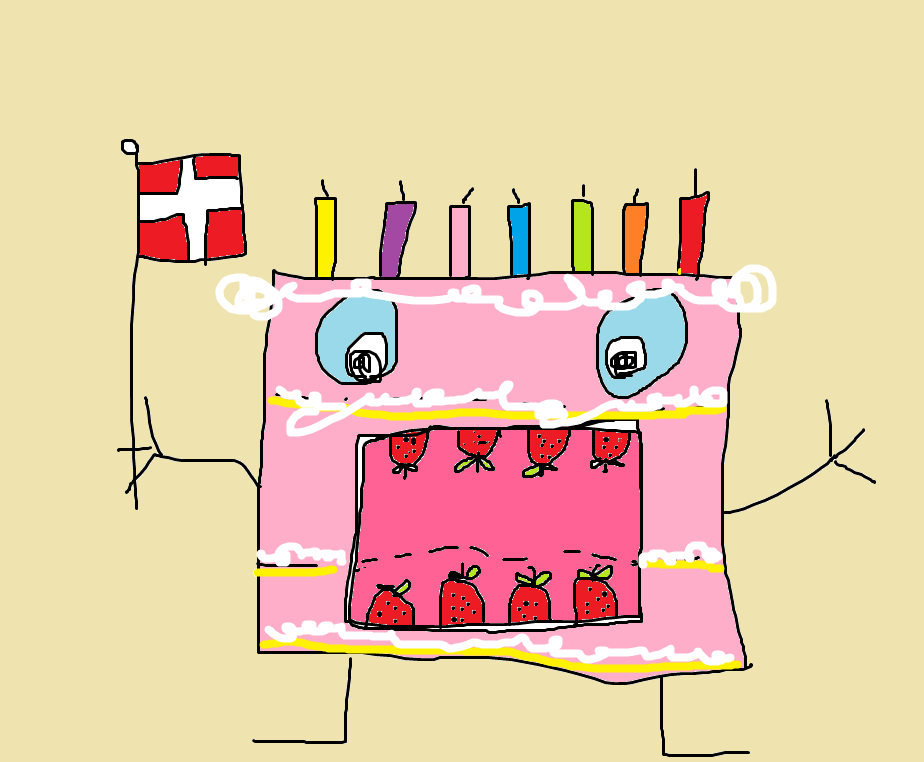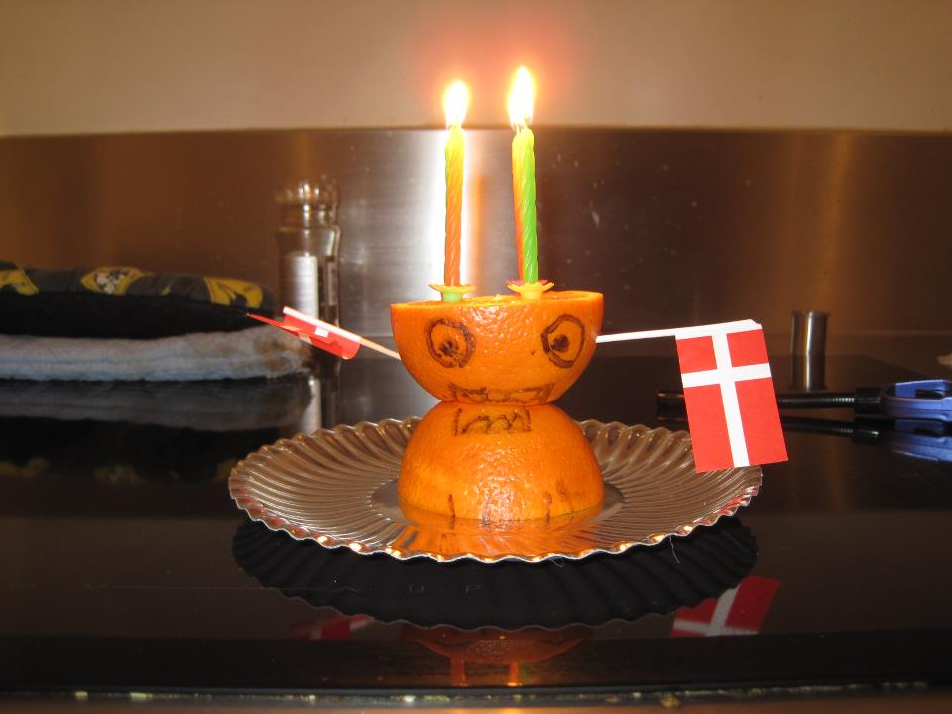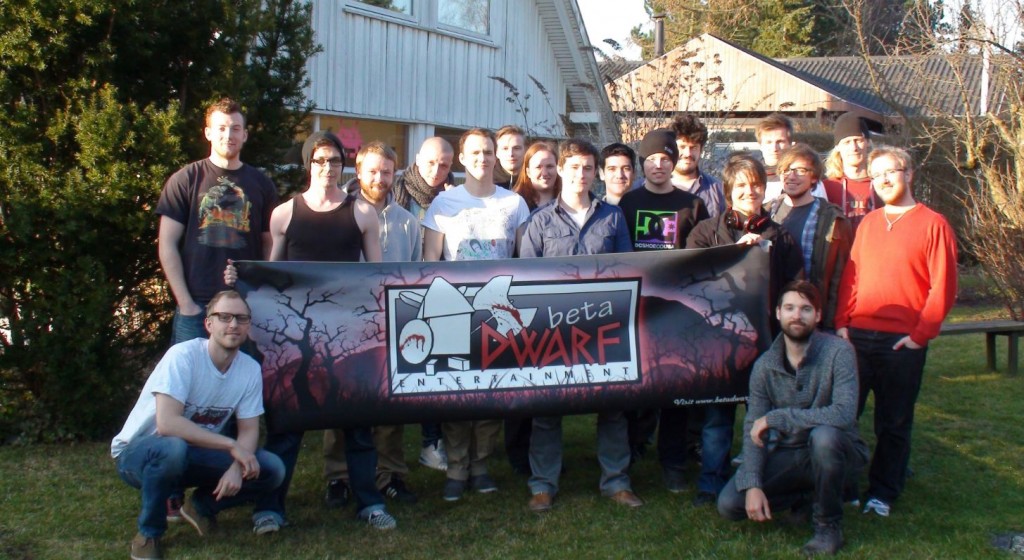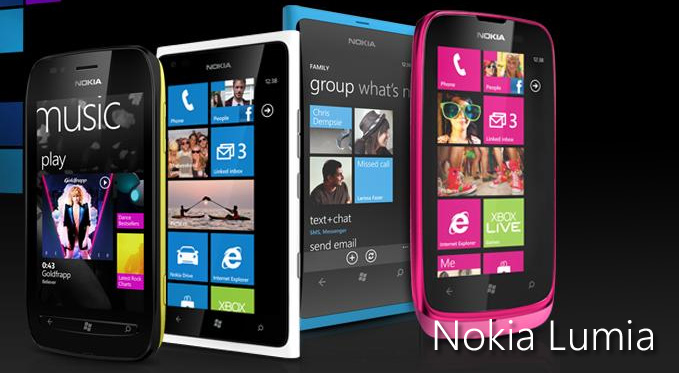This is all I have to say..
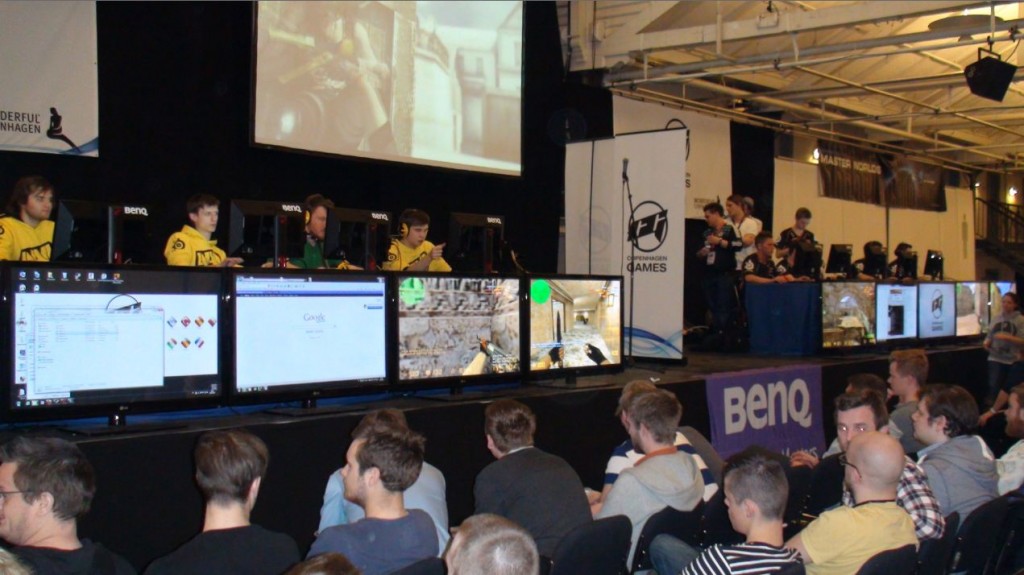
I have a confession to make:
Up until last week I had never seen any e-sports event. Not just that I hadn’t ever been to one in person, but I just seriously had no idea how big the scene was!
And now, after spending an entire day at Copenhagen Games with the awesome people at betaDwarf, I can say I’m amazed at all the craziness going on.
Starcraft II matches being commented live? Check.
Counter-Strike 1.6 teams full with their own jerseys? Check.
Booth babes giving away free coke and chewing gum? Check.
Lots of beer in Denmark? Check.
So what was I doing there? Capture every single moment on video, of course! betaDwarf had their booth in a very visible area, right next to the Snot! and World of Football booths, two amazing indie games under development right here in Copenhagen, and in front of the massive EA booth for FIFA Street.
And what was going on in our booth? You guessed! We were letting people play the latest playable build of Forced!
Forced is the new name for what was previously being called Faith of the Guardians, a co-op arena combat game in which up to four players will have to complete a series of challenges as gladiators.
Some of the people who stopped by and participated in our tournament to see which team achieved the highest score even walked out with Diablo 3 beta keys!
I’m sure you will be able to see what it was like at Copenhagen Games really soon at www.betadwarf.com, but meanwhile you can have a sneak peak with these pictures.
Anyone following me on Twitter or Facebook has probably already heard enough of my opinions on Apple’s latest announcements and their new generation iPad (which, by the way, ask any search engine optimization expert, and they will tell you that this is a terrible idea for a name).
But I wanted to take a few minutes to talk about why I think the announcement was a total disappointment.
It’s not because the new iPad is an awful device. Far from that, it’s probably the best tablet out there in number of apps, stability and design and, as Apple used to say, it simply works.
However we’ve all come to expect so much more from Apple than just better speed and a bigger resolution screen. It makes us think that this is not Apple we’re talking about, but instead any PC maker that simply upgrades their machines with better specs and cases them inside the same old. In fact, had Samsung or Sony presented these upgrades everyone would be incredibly happy with it and claim that this is the next revolution.
But it’s Apple who did it, and that’s a major downer.
Apple has got us used to always presenting “the next big thing”, to be leaders and innovators. Look at the day when Steve Jobs presented the first generation iPhone. That was a truly magical moment that changed the landscape of the entire mobile market. One year later and Apple announced the App Store, not a novel concept, but one done so well that everyone else had to follow suit. Look at the MacBook Air and compare it to what Intel is now finally trying to copy with its Ultrabooks.
And then there’s the iPad. A device that left everyone torn between this being a great idea or being a flunk. And time proved Apple was right, the iPad became a huge success.
That’s why when there’s a new Apple keynote coming up fans everywhere and even mainstream media start speculating about what Apple will surprise us with next. And usually they deliver, but that is simply not happening anymore.
The iPhone 4S presentation was an incredibly disappointing one for many: they all expected the iPhone 5, not a pumped up iPhone 4.
And the new iPad is just a rehash of that keynote. It’s faster. Oh, and it has a screen with a resolution so big that you’re not going to notice it is so good. In fact I feel that screen resolution is almost like buying an color TV to a color blind person.
I even made the following comic strip to represent my feelings on the new Retina Display:
But my point here is that Apple has got us all so used to delivering the next great piece of technology that will shape the future (in no small part thanks to its marketing strategy) that now, when they are simply not able to deliver something innovative, people get disappointed.
But you know what? It’s not going to affect Apple at all.
Their stocks fell a little bit yesterday, but I’m sure they will pick up, the new iPad sales will be excellent, and Apple will boast about it in their next keynote.
Meanwhile their competitors will fight to achieve something that gets any close to the iPad’s level of success. And they will keep failing at it just because they lack that marketing strategy to make things seem innovative.
But Apple, either you realize that you’re disappointing a lot of people or you won’t be able to keep up that “magical” aura out of your products.
It all started with a cake by Tim Garbos in Corinne’s Facebook wall for her birthday (as seen above).
And what started as an innocent little monster cake with a Danish flag became a series of back-and-forths between some of us to out-do the other. A real cake war!
In came Samuel Walz’s improved version of the cake, dubbed the Cakemonster 4.2 (in a seemingly random version upgrade) with:
– More candles
– More strawberries
– Improved danish flag (more cozy according to Sam and possibly attracting Spanish tourists)
– Candles already lit
This upgrade didn’t go unnoticed, and soon after Kristín posted on Corinne’s Facebook wall yet another improvement!
This new sexier version of the cake was now up to Cakemonster 6.8 (Woah! These numbers go up fast!) and according to the official changelog it included:
– Make-up, it’s what every cakemonster needs to feel oh so pretty
– Bigger shoes
– Two extra creepy fingers on each hand!
– Engraved candles
Then Kayode (feels so weird to call him like that now when we all name him K.) allowed us to take a break from monster cakes and gave Corinne a different kind of drawing. Birthday laser included.
But alas, it didn’t take too long before the Cakemonster evolved even more! Now it went up to a more stable-looking version 7, courtesy of Freyr!
This version’s biggest upgrade was obvious: the Cakemonster was now together with its extended family! (With a lovely meme in the background).
At this point even Google joined the cake party!
Meanwhile I was deciding how to add my two cents for Corinne’s birthday, and seeing how I was in the 3D Game Art course at that moment it just felt right to take the cake to the third dimension!
Apparently the one who started this entire cake trend, Tim himself, felt up to the challenge. After all my cake was in 3D, sure, but it was not our dearly beloved Cakemonster! So here came the new 3D rendition of it by Tim!
Taking it personally (I mean, come on, Tim did publicly state that his cake was meant to beat mine!) I declared the Cake Wars and quickly returned this personal attack with the following picture with my cake angry and ready to cut the Cakemonster (9.3? I lost count of the version number already!) in pieces:
But it seems like you cannot simply take it against Tim’s cake and leave unscathed… His next move took it yet one step further! The Cakemonster could now move and do a backflip! Or a sideflip… Or… well, something that ends with lots of colorful lines! It lacked the several improvements made during the day, but hey! It jumps! And that’s awesome, right?
Ok, so he’s made the Cakemonster animated? Alright! I’ll take it on! I’ll make it interactive!
After all we’re Game Designers in here, so why not quickly learn how to do a simple First Person Shooter with the Cakemonster?
Of course a picture just doesn’t show the full thing, so why not give the game a try? It’s available here and it only needs the Unity Web Plugin to play!
At this point Tim had made me think that he was giving up and would not take it further (LIAR!), so I happily sat down… until an unexpected challenger raised up!
The duo of Samuel and Kayode surprisingly made this flash game based on Space Invaders, with with the Cakemonster (this time once again in its latest version) attacking… both Tim and me. Oh noes! Nice touch with the custom-made music, by the way! Of course you can also play it yourself here!
Were these two the winners of the Cake Wars? Up to now Corinne had received more than enough cakes and Cakemonsters to make this for her most delicious birthday yet.
But NO! That was definitely not the end of it! While I couldn’t stop laughing at the second Cake Wars game, Tim had inadvertently created something that could easily surpassed any digital cake! He made a REAL cake in just under 30 minutes!
Sure, it’s made out of an orange. But it’s still a cake with two candles! And two Danish flags! And it’s still a Cakemonster (11.7?).
That last sneaky move was performed 5 minutes before midnight, thus officially closing Corinne’s birthday. I gave up, I couldn’t reply on time and Tim Garbos won this Cake Wars.
And I’m sure this is one war that will go down to the history books
Poor Kristian Klie, he thought he could escape me and my camera and survive in betaDwarf without having a major role in one of the developer diary series I’m doing for them. Last time he had a class to assist in as a TA, but this time he just couldn’t run away. I made him host the third episode and get viewers to know a little bit more about the way people work here.
Programming, designers insisting on programmers, programmers taking a break, programmers talking about cabbages with musicians… (ok, that one is NOT in the video, but I can assure you that it happened!).
Oh! And did I say musician? Yes indeed! Special thanks go to Fredrik Häthén for providing a very amusing monologue about music. And coffee. And Totoro… And well, countless other things that just didn’t make the cut for this video but might pop up some other day.
But of course also to the entire betaDwarf team! Weren’t it for the craziness that you all provide, these videos wouldn’t be the same!
So here’s the latest video! Please share it, tweet it, like it, comment on it or anything that comes up to your mind!
Oh, and as an extra, here’s a company picture! (In which the photographer had to be photoshopped in…)
Nokia’s return to form
Today was quite an interesting morning that gave the first official day of the Mobile World Congress 2012 in Barcelona a nice start. And it was all because of Nokia’s keynote with head honcho Stephen Elop.
Sure, the Nokia Asha line of phones is definitely a great addition for the company’s line-up, but those are not my main interest considering that they are designed for the emergent market at very low price points.
But on the other hand there was the Nokia Lumia family of phones. In just a few months we’ve seen now a total of 4 models with different shapes and styles and each one tailored for a separate userbase: the Lumia 800 and Lumia 710 came first as both a high-range and medium-range phones respectively, then came the Lumia 900 with a bigger screen and front-camera for the US market (now heading worldwide as well) and today the Lumia 610 joins Nokia’s Windows Phone 7 line.
Now though, ever since Elop announced that Nokia was jumping into the Windows Phone bandwagon because this allowed them to stand out and differentiate themselves there have been countless blog posts and comments saying that it was a stupid move and that Nokia should have either gone full-on with Meego or changed their track to Android. And I have been disagreeing with that point of view from the very first moment. Not because I think that Windows Phone is the superior platform, but because it was the most logical move for Nokia the way things were going for them.
Let’s face it: when was the last time you were genuinely surprised by a Nokia phone? What happened to the company that was once the true innovator of mobile technologies and biggest camera manufacturer in the world? Many could point at the Nokia N95 as the last phone that truly wowed the world, with its innovative form factor and high-end multimedia capabilities. But ever since then their offerings have always had problems everywhere: slow performance, a horrible, outdated user interface, cheap materials…
Joining forces with Android would have only been a disaster for the Finish company, who would have to bake a really outstanding custom UI in Android in order to gather some attention into the already over-crowded Android phone market. But at the same time that would have alienated many Android users who prefer things untouched in the OS and ready to be customized by them. Either way it was a losing situation. And the fact that the entire US market was lost to Nokia only made things worse.
Enter Windows Phone, Microsoft’s latest mobile operating system that has received a lot of praise for being something truly fresh and with intuitive design, though lacking in the apps department. As an OS that was starting to raise awareness among people on the streets, Nokia had the chance to spearhead the advance of the Windows Phone ecosystem by leading a space that was largely left untouched. And so it did, with incredibly positive results in pretty much every country where Nokia has started selling their new Lumia phones. It has effectively become the biggest vendor of Windows Phones, surpassing both HTC and Samsung. And it has done so by simply doing what Nokia does best: creating top-notch high quality designs, while letting Microsoft do their part on the OS.
And now look at the Lumia 610: it’s bound to become the entry-level Windows Phone to look at. And as far as low-end smartphones goes, this could very well be the most interesting one of them all. Look at Android smartphones: either you take the high-end or you end up with an extremely low budget phone with cheap plastics and a horrible user experience that runs slow and has problems running every app or scrolling down a contacts list, besides having a low screen resolution that makes things look cramped in the small screen.
The Lumia 610 on the other hand represents one of the biggest advantages of the Windows Phone platform: it still runs smooth, maintains the same screen resolution as its big brothers and keeps Nokia’s characteristic design aesthetics (although with a cheaper, less color-accurate screen and a plastic case). And Microsoft claims that only 5% of the current apps in the marketplace (which is now over 70.000 apps) won’t work as they are right now, though a few tweaks could make them work. This keeps fragmentation up to a minimum in a phone that is under the 200€ mark. Imagine doing that with Android phones.
This will be the phone that will introduce many to the Windows Phone ecosystem, and maybe smartphones as a whole. And the fact that as an entry smartphone it still manages to run smooth and with all the style of the Metro user interface only makes things more amazing for Nokia.
And then there’s the Nokia 808 PureView, the other grand announcement from Nokia at the MWC12.
Now, I’m a little bit torn on this one. Nokia has created a phone that has a 41 megapixel camera. And it runs Symbian.
What?
First the camera part: do we really need a phone with such a high photo resolution? Is it going to help anyone to keep excessively huge photos taking up space on their memory cards and slowing down the experience of scrolling through the photos? I mean, it should be clear that more megapixels doesn’t necessarily have to mean better quality pictures, but rather a big host of specs that go from the lens of the camera to the software that manages it. Nokia has shown us before that they know how to make cameras so I’m not too worried about the quality of these pictures. But those 41 megapixels sound more like a marketing gimmick than a real improvement, and Nokia is risking looking like a big gimmick to its customers.
But on the other hand this camera has its advantages. With such a high resolution it is possible to perform digital zoom to high levels without compromising the quality of the final picture. Yes, I know that digital zoom is not as good as a proper optical zoom. But when you consider that including an optical zoom in a phone would immediately mean a thicker, heavier phone, this option presents itself like a nice opportunity to improve the way camera phones evolve in the future.
As for the choice of the OS… I understand that Windows Phone as it is wouldn’t allow Nokia to create the necessary software adjustments needed to use this type of camera. At least not in its current version (leaks show that Apollo will allow OEMs to do a lot more with that). So Symbian was the way to go for now. I can see Nokia marketing this phone as a camera-enthusiast phone, aimed at that specific niche and not as a mainstream device, learning from it and improving what they can until they can use this new technology for their future phones, now on Microsoft’s platform.
Or at least that is my hope for them.
But all in all Nokia has shown us today that they are far from dead. The upcoming release of the Nokia 900 to the US market with the help of Microsoft’s push could allow the Finnish company to finally make a dent in the Android-iOS filled country where it always has had trouble establishing itself. And in Europe it can once again regain the lost market share with their cool designs that definitely make a difference in this era it almost feels like phones should always be black blocks with one button on the bottom of the screen.
Personally I’m looking forward to see the effect these new phones will have in the market as a whole. And of course I’ll be waiting impatiently to play with them on my own and put them to the test.





